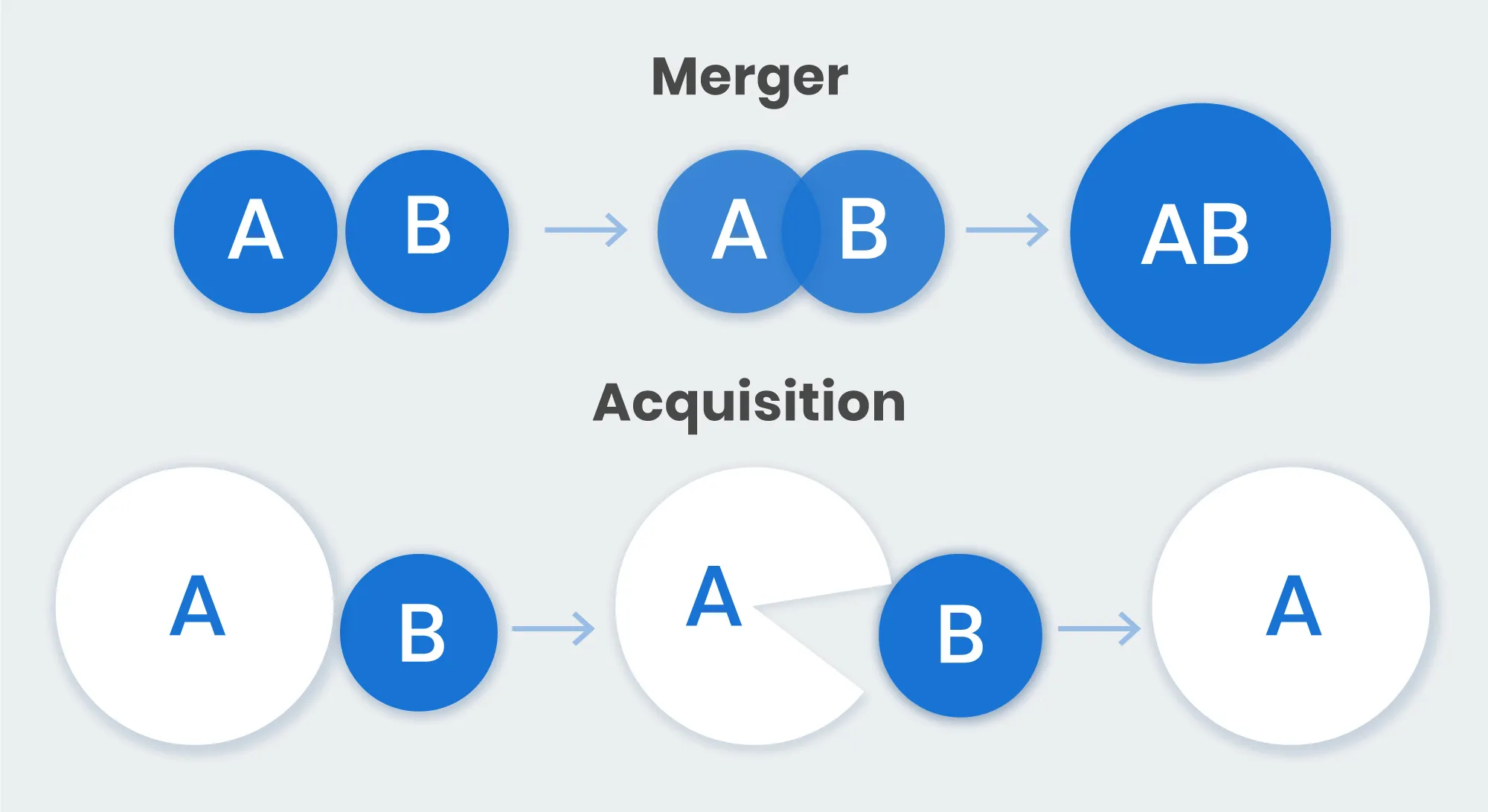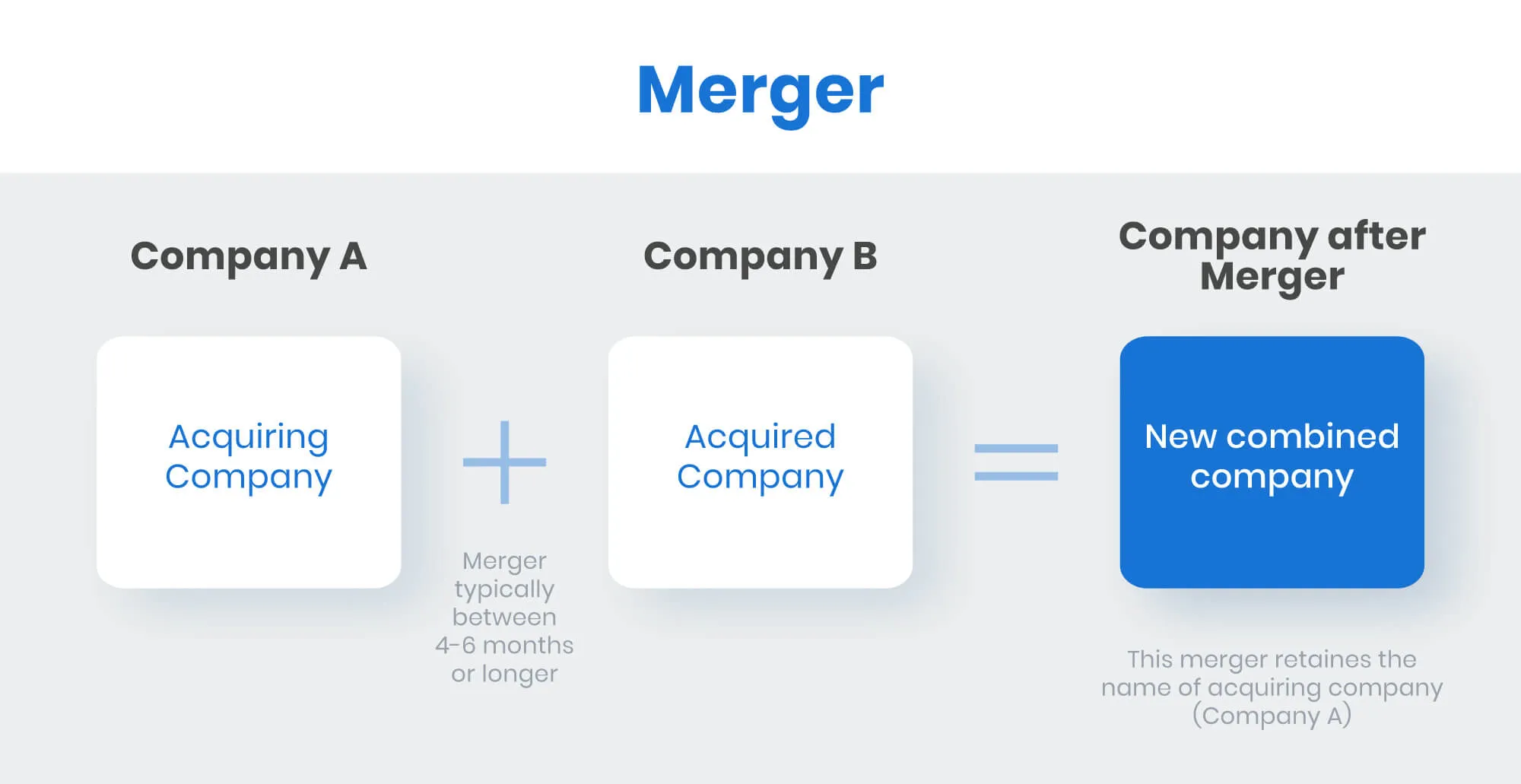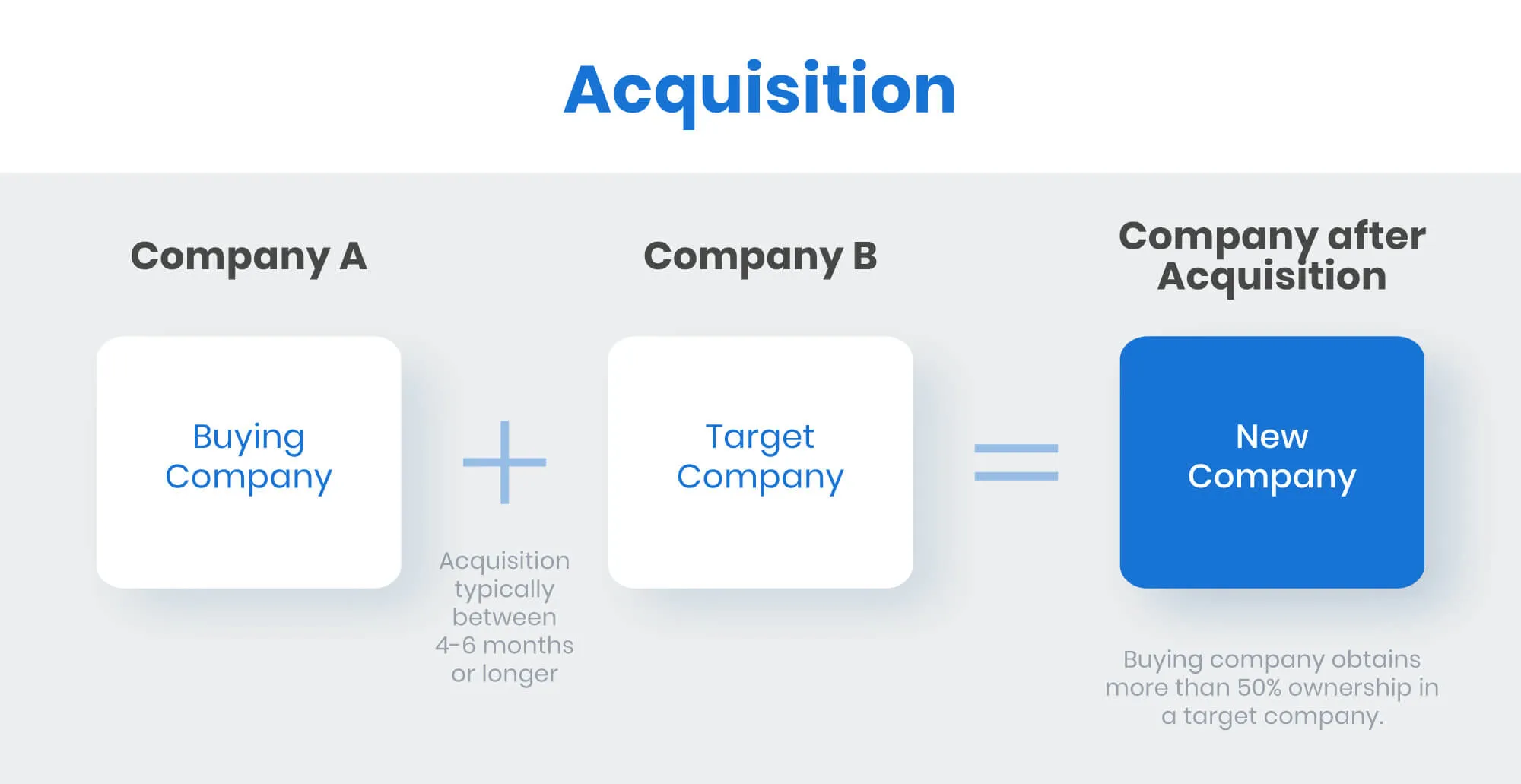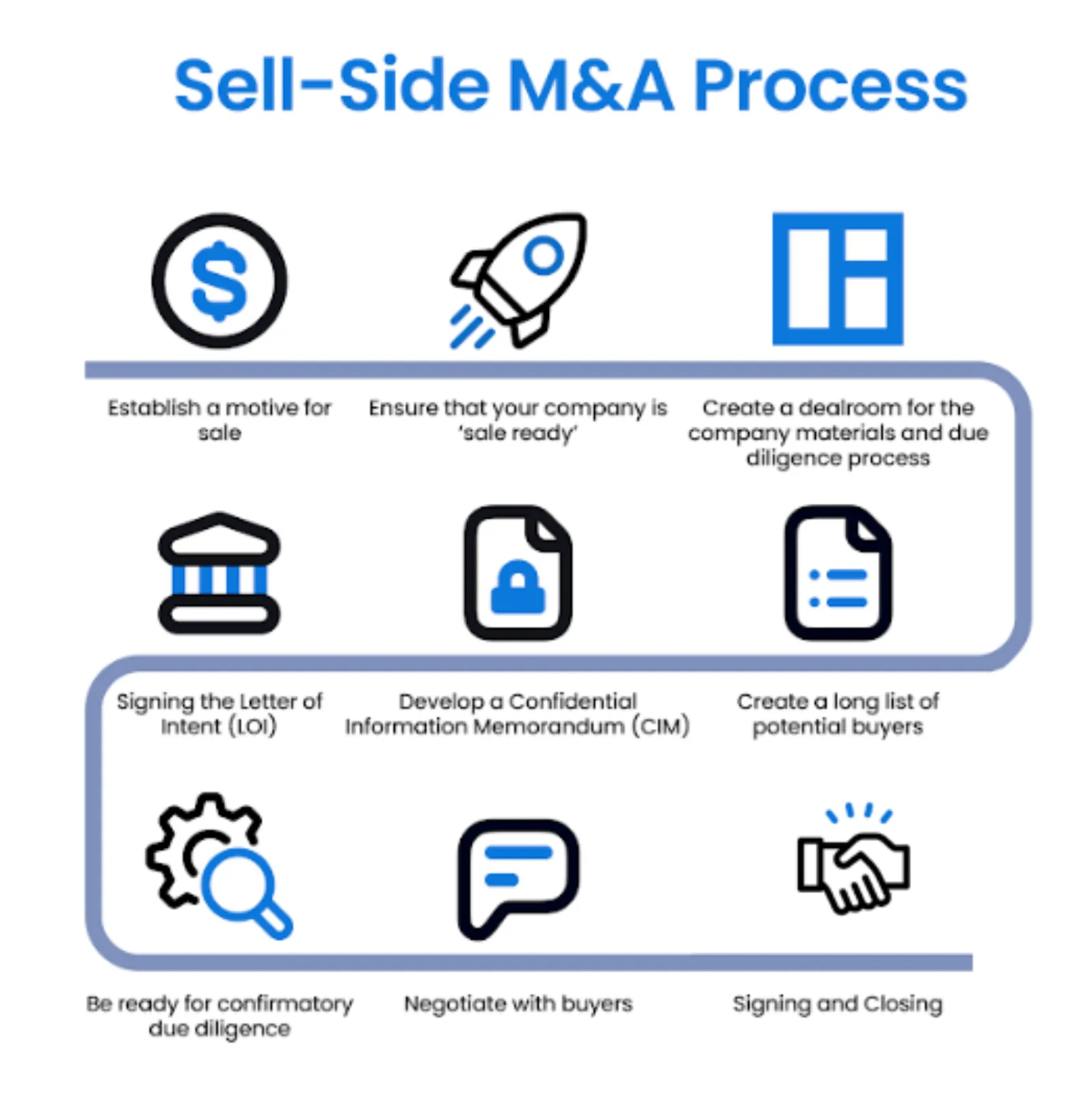Guide to Mergers & Acquisitions: M&A Meaning, Types, Examples


Mergers and acquisitions (M&A) is a $3 trillion activity that changes the long-term trajectory of careers, companies, and industries. Outside of an IPO - and even that is arguable - an M&A transaction is the largest corporate action that any company can take in its lifetime.
Outside of startups, there is not a billion-dollar company in existence that has not participated in at least one M&A activity. Therefore, there is simply no excuse for being uninformed about what goes on in this industry.
We at DealRoom are highly involved in the M&A space and have put the following guide together as a prime for those looking to learn more.
So, let's start with M&A definition and meaning.
What are Mergers & Acquisitions (M&A)?
Mergers and acquisitions (M&A) is the process of combining two or more companies through various types of transactions. Despite the name, M&A goes beyond buying or selling a company. Afterall, there are other ways to combine companies together without any party giving up ownership. Let’s look at some of the most common types of M&A.

Different Types of Mergers & Acquisitions
1. Mergers
A merger is a corporate strategy of combining two separate business entities of roughly the same size into a single company to increase their financial and operational strengths. Unlike an acquisition, corporate mergers are mutual, and both parties feel they will benefit from the transaction. Typically in a merger of equals, there is no massive cash payment involved. Most of the payment is made through the stock exchange, where shareholders of both companies receive shares in the newly formed company proportionate to their old shares.

2. Acquisition
An acquisition is the purchase of the entire company or a particular asset of the target company. This involves payment to the seller and the transfer of ownership to the buyer upon closing. To make successful acquisitions, the M&A process usually involves strategic deal sourcing, careful due diligence, and efficient integration post-close.

3. Reverse Merger
This is a less popular but very effective way for private companies to go private. In a reverse merger, the private company buys most of the shares of a public shell company and then merges with it.
4. Joint Venture
Joint ventures are mutual agreements between parties to pool their resources and expertise together to pursue a specific goal. A distinct characteristic of this agreement is that the parties will create a new company or entity and operate it separately from the parent companies.
The perfect example of a joint venture is the agreement between Sony and Ericsson in 2001. They joined forces to create Sony Ericsson with the goal of dominating the mobile industry using Sony's expertise in consumer electronics with Ericsson’s strength in telecommunication.
5. Strategic Alliances
Strategic alliances are similar to joint ventures, with one major difference: They don't form a separate entity and operate independently.
A very current and popular example of this is the agreement between Toyota and Subaru for the development of the Subaru BRZ and Toyota GT86. For these particular vehicles, they both leveraged Subaru’s expertise in engine performance and Toyota’s capabilities in manufacturing and design.
6. Partnerships
Partnerships are very similar to joint ventures, but they differ in their structure, purpose, and duration. Partnerships are not restricted to a specific goal but rather run a long-term business, sharing profits and liabilities. Also, partnerships don’t have a duration period and can last perpetually.
Different Types of M&A Strategies
In M&A, it’s not as simple as buying or merging with another entity. Various strategies behind it will directly affect how both companies integrate with one another. Understanding them will result in better integration and increase the chances of success of the mergers and acquisitions. Here are the different types of M&A strategies.
1. Horizontal M&A
A horizontal merger and acquisition combines two companies that provide the same service or product to final customers. In short, they are direct competitors, merging into one entity to increase market share. These transactions are heavily regulated by the U.S. Department of Justice (DOJ) and the Federal Trade Commission (FTC) to prevent monopolies and protect consumers from illegal pricing.
2.Vertical M&A
Vertical M&A involves two companies that are not competitors but are in the same industry. They are more likely to produce goods or services for the same product but are in different stages within an industry’s supply chain. For example, if a car company acquired another company that supplied seat belts for the cars, that would be a vertical merger and acquisition. The goal is to control more stages of the production and distribution process, which can lead to cost reductions.
3. Concentric M&A
Concentric M&A involves two businesses that have the same customers in a specific industry but they offer different products and services. An example would be a cell phone company merging with a cell phone case company.
4. Conglomerate M&A
This type of M&A involves combining two companies that have unrelated business activities. Conglomerate mergers are typically done to expand into other industries.
5. Product Extension M&A
A product extension M&A is a type of transaction in which companies sell different but related products in the same market. For instance, a pencil manufacturer might merge with a company that produces erasers. The goal is to diversify products and offer more to the same customer base.
6. Market Extension M&A
This type of M&A involves two companies that sell the same products but are in separate markets. A market extension merger is usually done to increase geographical reach and gain access to a larger customer base. An example is a company in the United States merging with a company in Europe to gain access to each other's market. This cross-border deal allows the acquirer to achieve new market opportunities and international growth.
7. Bolt-On Acquisitions
This type of acquisition usually involves a larger company buying a small business to expand its existing business segment and enhance its existing operations. In this strategy, the smaller company may retain its name and identity.
8. Tuck-In Acquisitions
Tuck-ins are very similar to bolt-ons, with one major difference. The buyer completely absorbs the small business and loses its corporate identity.
9. Roll-Ups Acquisitions
The roll-up strategy is a specific type of acquisition strategy where a company, mostly private equity firms, acquires multiple smaller companies in the same market and merges them into a new legal entity, forming a single larger one. It is also known as consolidation. The goal is to form a dominant entity in a highly fragmented market.
10. Hostile Takeover
Despite popular belief, not all acquisitions are mutual. Hostile takeovers is a type of acquisition where the acquirer forces to buy the target company against its wishes. This is only possible if the target business is a public company.
Read our article on 8 examples of hostile takeovers.
11. Capability Acquisitions
This strategy is extremely popular in industries where technological advancement and specialized skills are pivotal. Capability acquisitions is when a company acquires another company specifically for its capabilities that it does not possess. These capabilities can include new technologies, intellectual property, or operational processes.
12. Acquihire
Acquihire is a strategy that primarily focuses on acquiring a company's stakeholders or employees. This strategy is extremely common in the tech industry, where the competition for talented engineers, developers, and leaders is intense.
Why Companies Go for Mergers and Acquisitions
Before the M&A process begins, there are countless considerations from key executives, including the board of directors. But in a nutshell, the motives for mergers and acquisitions tend to fall under one of the following:
1. Synergies
Synergies describe the extra value generated when two companies combine, or simply put, “one plus one equals three". This occurs when a resource such as capital or intellectual property is shared between the two firms in the new entity, allowing two companies to benefit from the resource instead of one. There are two types of synergies:
a. Cost synergies – these are cost reductions incurred from combining the two entities. The most common example of this is economies of scale. Larger volumes will result in better discounts from suppliers.
b. Revenue synergies—These are additional sales or revenue that the combined entity will generate. The most common example is cross-selling to both companies' customers
2. Expansion
M&A is a terrific way to enter new markets, expand geographic reach, and achieve diversification of product portfolio. Instead of building these things from scratch, buying another company will produce these goals instantly while generating revenue. Think of a US company that wants to gain access to Asian markets. Starting a business from scratch in a foreign country can be a painful process compared to buying an Asian company with an existing influence in the target market.
3. Defensive Play
Defensive play simply means a company buying its competitors. Buying the competition will increase its market share while eliminating potential threats in the future. This is extremely common for large companies facing startups.
One of the most famous M&A examples is Google's acquisition of YouTube in November 2006. YouTube was a fast-growing video-sharing platform starting to draw significant online traffic. Google saw this as a threat to its digital advertising market and decided to buy it for 1.65 billion.
This strategic move allowed Google to protect its advertising revenue and expand its presence in the online video market.
4. Capability
There are also instances where the acquiring company makes acquisitions to gain certain capabilities and enhance its existing operations. A great example of this is Amazon's 2012 acquisition of Kiva Systems, which specialized in automation technology for warehouse management and fulfillment centers.
Amazon acquired them for $775 million to streamline its warehouse operations, reduce shipping times, and decrease costs through advanced robotics and automation technology.
5. Tax Benefits
Tax benefits can also be a major reason why companies do M&A. By combining businesses, companies can often use tax laws to their advantage and reduce their overall tax payments. For instance, if a company bought another business that has been losing money, those losses can be used by the new owner to pay less taxes in the future.
How Do Companies Finance Mergers and Acquisitions?
1. Cash
Cash is the most straightforward way of doing M&A deals. Using the company's cash reserves, the buyer pays the seller a specific amount in exchange for the company's ownership. This method is most appealing to the sellers because it offers immediate payment.
On the other hand, the acquiring company would want to hold on to their cash for as long as possible unless interest rates are too high.
2. Debt Financing
Debt financing involves companies borrowing funds through bank loans, bonds, and other forms of debt to pay for the transaction. They have several options of sources: commercial and investment banking, private equity firms, and more.
If interest rates are low, debt financing would be the company’s first option to still use their cash reserves in other investments and maximize opportunities.
3. Seller Financing
There are also instances where the seller agrees to finance the transaction on the buyer's behalf. In short, the seller agrees to deferred payment in exchange for a slightly higher purchase price. This type of transaction requires a lot of trust between the buyer and seller.
4. Stock Payments
In this scenario, the buyer pays the seller using their company’s shares. This allows the buyer to acquire the target company without using cash or leveraging their balance sheet. This method can also be attractive to the seller if the acquirer’s stock is valued high and expected to perform even better after the acquisition.
5. Earnouts
Whether it's used as a financing strategy or to bridge valuation gaps, earn-outs simply mean the buyer agrees to pay a certain amount upfront and then additional payments based on the future performance of the business sold.
For instance, the seller is asking for $150 million for their company, and would not negotiate for anything less. The buyer can now employ an earn-out and agree to pay 120 million upfront, and the remaining $30 million would be subject to future performance.
M&A Process Explained
To understand the M&A process, it’s helpful to understand both the buy-side and sell-side M&A process.
Sell-Side M&A Process Steps
- Establish a motive for sale
- Ensure that your company is ‘sale ready’
- Create DealRoom for the company materials and due diligence process
- Create a long list of potential buyers
- Develop a Confidential Information Memorandum (CIM)
- Signing the Letter of Intent (LOI)
- Be ready for confirmatory due diligence
- Negotiate with buyers
- Signing and Closing

Buy-Side M&A Process
- Develop an M&A Strategy
- Develop a search criteria
- Develop a long list of companies for acquisition
- Contact target companies
- Preliminary due diligence
- Negotiations
- Letter of Intent
- Confirmatory Due Diligence
- Signing and Closing
- Integration

DealRoom’s due diligence product also has project management capabilities designed to address the many challenges in M&A. It should be considered a critical element of the process by any company undertaking agile M&A.
Get your M&A process in order. Use DealRoom as a single source of truth and align your team.



.webp)





.png)
.png)
.png)
.svg)

.svg)
.png)


